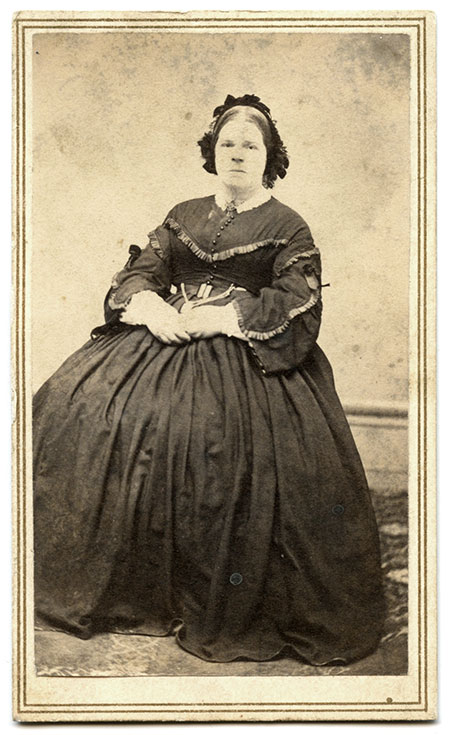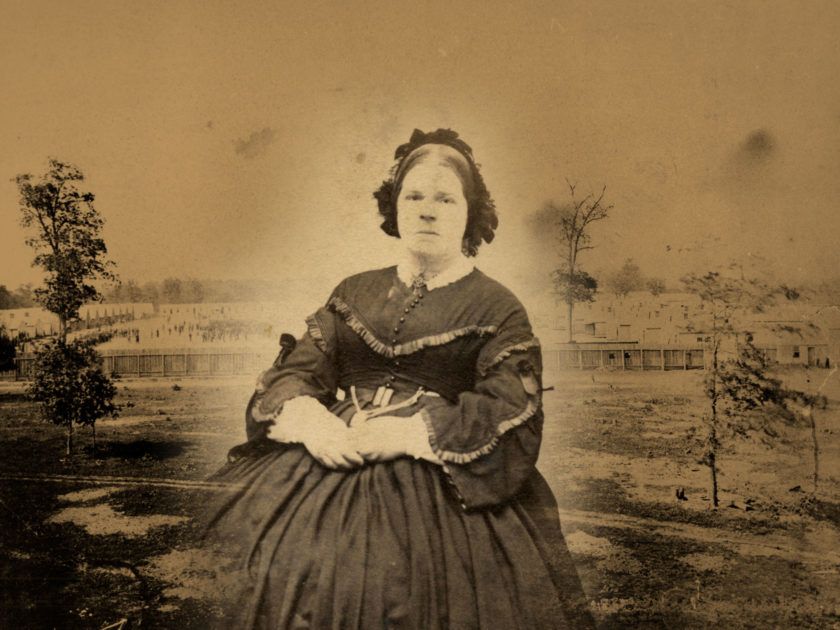By Kathleen Heyworth
Conditions at Camp Butler were wretched by almost any standard. A federal training and Confederate prisoner of war camp located near the Illinois capital of Springfield, its inhabitants fought an uphill battle against sickness and disease. One Union soldier, Sgt. Maj. Stephen F. Fleharty of the 102nd Illinois Infantry, quoted a line from an old poem when he described the camp, “Death rides on every passing breeze and lurks in every flower.”
By January 1864, the camp was well on its way to its grim death toll of 1,500 souls. The military responded by issuing reports and orders detailing how to eliminate the underlying causes of sickness and disease. It also brought in a secret weapon: Sarah Gallop Gregg. A seasoned nurse in her mid-50s, the army offered her a job as Matron of the camp hospital and asked what it would take to hire her. Sarah replied that she wanted $50.00 a month. When they balked at the salary, she told them, “I could do as much good in the army as a Colonel and I ought to have good wages!” They settled on $25.00.

She likely never imagined that she would be called to serve. Just a few years earlier, New York born Sarah and her husband, David, lived a quiet life in Ottawa, Ill., where they had settled in 1848. She owned a millinery shop and he was a painter. They had two children, a daughter who died young and a son, William. He and his father were both Mexican War veterans.
When the Civil War came in 1861, David decided to join the army. Concerned that he was too old at 54 for soldiering, he gave his age as 44 and enlisted as a musician in the state’s 10th Infantry. After the regiment’s three-month term expired, David rejoined the army as a private in the 1st Illinois Light Artillery. William would also return to the army.
David fell ill at some point and was sent to a military hospital in Mound City, Ill. Though sick, he was able to help out around the hospital. A concerned Sarah left home and traveled 350 miles south to visit him. On New Year’s Day 1863, she began a diary to record her activities. One of her early entries describes a hospital steamer full of sick and wounded men lying on the deck without cots, blankets or even straw. She had never seen “a more pitiable sight.”
Perhaps worse than the sights was the sound. “The moans of the wounded and maimed in every conceivable way, heard in the wards,” Sarah observed, “ were horrible to hear.” Moved to action, she sent a request to Mary Livermore, the influential nurse who headed up the regional U.S. Sanitary Commission division, for much needed supplies. Livermore refused to help because Sarah was not in Mound City in an official capacity. An angry Sarah confided in her diary, “Too much red tape about this matter. God forgive them, for no one else will.”
Livermore however had been impressed. A few weeks later, she extended an invitation to Sarah to meet in Chicago. The result: Sarah became the Matron of Camp Stebbins Hospital in her hometown of Ottawa. David joined her after he received a medical discharge in March 1863.
“Death rides on every passing breeze and lurks in every flower.”
Meanwhile, the military situation in Vicksburg heated up as the spring campaign season got underway. Maj. Gen. Ulysses S. Grant launched renewed operations to capture the Confederate fortress city along the Mississippi River. Grant’s moves would eventually bring success—and waves of casualties.
On May 25, 1863, Sarah was temporarily detached from her duties to assist. She and David soon left for the Mississippi River base at Cairo, Ill., where they boarded the Sanitary Commission hospital steamer City of Alton. Sarah spent her 53rd birthday on the ship, escorted by gunboats as the vessel slowly approached the embattled city.
The City of Alton arrived at its destination about three miles outside Vicksburg on June 9 and left a few days later bound for a military hospital in Memphis, Tenn., with 140 sick and wounded soldiers on board. At one point, Sarah recalled, they passed a convoy of 24 Union vessels packed with troops destined for the front. The soldiers took note of the steamer’s yellow flag, the symbol of a hospital boat, and responded with rousing “cheer after cheer” and joyously sang the “Battle Cry of Freedom.”
On June 17, the steamer arrived in Memphis. Sarah, David and the other caregivers delivered their patients to the hospital. Sarah also met Mary Ann Bickerdyke, the fiercely determined nurse known as “Mother” Bickerdyke to her patients. The meeting was brief, as the City of Alton left the same day with 250 more soldiers headed for St. Louis. The ship arrived three days later and marked the end of the journey for Sarah and David. They soon returned to Ottawa and Sarah resumed her duties at Camp Stebbins.

Six months later, David was back in uniform with the 53rd Illinois Infantry and Sarah was starting her new job as Matron of the Camp Butler Hospital. By this time, the Confederates were no longer there. She was initially disheartened and dismayed at the miserable condition of the 400 Union patients, and disappointed with the poor state of the facilities. The weather did not help. She wrote upon her arrival on Jan. 31, 1864, “It was pouring rain, the mud was knee deep,” and that she had never seen “a more gloomy time.” Every day for the next week, she reported the number of deaths in the camp hospital. She somberly noted, “Ten of our soldiers were buried today. They were taken from the dead house and put into a wagon. A band accompanied them, one playing the Dead March. The wagon was drawn by four mules. That was the saddest sight I ever saw.”
She vowed “with God’s help I will make them more comfortable.” For the remainder of the war, she worked tirelessly to do so for the soldiers in her care, and they loved her for it.
Sarah hung curtains and pictures cut out of magazines to brighten up the ward walls. She did simple things to nourish the patients. To feed their bodies, she planted a vegetable garden. To feed their souls, she planted a flower garden. Months after one sick soldier, Pvt. William W. E. McIvers of the 10th Illinois Infantry, left her care, she received a letter from him which said, “Mother, you haven’t any idea how many times I wished myself back to the hospital so that Mother would give me a piece of bread and butter or something else good but a soldier is a soldier and can’t be anything else. The men that left when I did are all well and Norris says he would like to see your flower garden.”
In addition to her myriad duties, Sarah found time to comfort the patients. She read to them, wrote letters to their families and attended funerals. She visited the graves in camp. “Poor fellows,” she lamented, “it was sad to contemplate.”
Sarah unquestionably saved lives that might otherwise have ended prematurely. But there were some beyond help. One of them was a most unexpected patient, the pregnant wife of a sick soldier identified by Sarah as Mrs. Shrum. On Feb. 26, 1864, Sarah wrote, the woman gave birth to a “very pretty little girl.” The mother tragically died within 48 hours of the birth. Sarah noted that the “feeble wails” of the baby were “oddly out of place in a ward filled with sick and wounded men. To many it must have brought back thoughts of their own small children hundreds of miles away at home.” The infant spent her first three weeks in the care of another nurse. On March 21, the child was taken to the home of a Springfield family.
“Summarizing her services, they declared that she ‘has truly been the soldier’s friend.’”
On one early spring day, Sarah went for a walk in a grove near the camp. She reflected that even though the grass was now green and birds were singing there is always “a melancholy that surrounds us.” In addition to the ever-present sickness and death that surrounded her like a death cloak, she was anxious about David’s well being. He and his regiment participated in the Atlanta Campaign and were in the thick of the action through the summer, and Maj. Gen. William T. Sherman’s “March to the Sea” in the autumn.
On Dec. 27, 1864, Sarah had her likeness made in Springfield. The carte de visite portrait tells a story. She appears to be a woman in mourning. Though an undeniable look of determination on her face is evident, an overwhelming look of sadness in her eyes dominates. This is a reflection of the reality of war.
The sadness deepened when, on April 16, 1865, she learned of the assassination of President Abraham Lincoln. She recorded in her diary that it was a beautiful day, but that “sadness pervades everything…everyone feels as though they have lost a father. This is the saddest day our nation ever experienced.” A few days later, without evoking the name of John Wilkes Booth, she angrily wrote that the assassin was a “low and miserable wretch.”
Sarah had a unique tangential connection to Lincoln. As matron, she worked closely with the Springfield Ladies Soldiers’ Aid Society and Lucretia Tilton, the organization’s president. The Tiltons rented the Lincoln’s home while the Union’s first couple was away in Washington, and Sarah stayed there when business brought her to Springfield. She always noted in her diary, with great pride, that she slept in the President’s home.
Two months later, on June 20, 1865, Sarah left Camp Butler after she received her official discharge papers. Before she left, 100 of the convalescents who remained at the hospital presented her a letter of gratitude and praise. Summarizing her services, they declared that she “has truly been the soldier’s friend.” She spent the next week in Springfield, making jelly, waiting tables at a soldiers’ dinner at the State House, and saying goodbye to friends.
On June 26, she spent her last night at the late President Lincoln’s home. The next day, her husband arrived in Springfield on furlough from Louisville. They met on the street and took the train home to Ottawa, where they returned to their quiet pre-war lives—David as a painter and Sarah as a shop owner.
Sarah never rose to the fame and esteem of fellow Illinois civil war nurse Mary Ann Bickerdyke. She however was honored by a grateful nation through a Special Act of Congress. On July 6, 1886, she received a military pension of $12.00 a month. She died in 1897 at age 86.
References: Stephen F. Fleharty, Jottings from Dixie; Sarah Gregg diary, Abraham Lincoln Presidential Library, Springfield, Ill.; Inter-State Publishing Co., History of La Salle County, Illinois.
Kathleen Heyworth is a native of Central Illinois. She earned a Bachelor’s and Master’s degree from the University of Illinois, Springfield. She is the author of Private Lewis Martin and African-American Civil War Soldiers in Springfield, Illinois.
SPREAD THE WORD: We encourage you to share this story on social media and elsewhere to educate and raise awareness. If you wish to use any image on this page for another purpose, please request permission.
LEARN MORE about Military Images, America’s only magazine dedicated to showcasing, interpreting and preserving Civil War portrait photography.
VISIT OUR STORE to subscribe, renew a subscription, and more.

